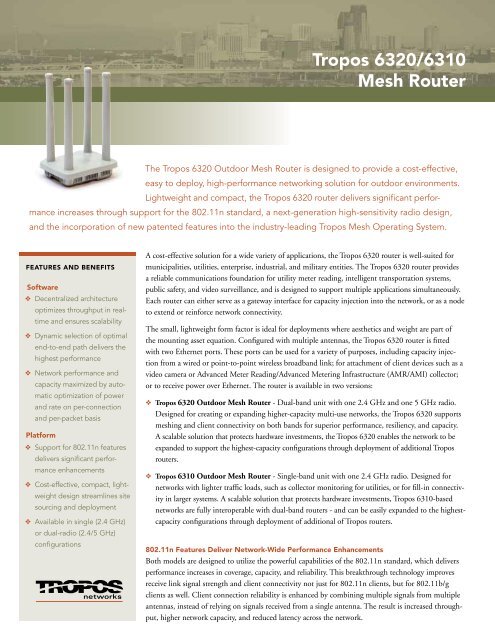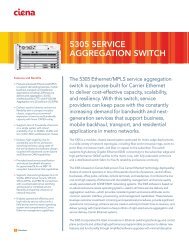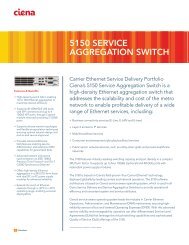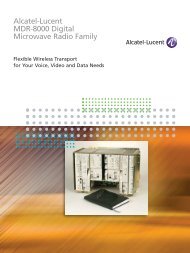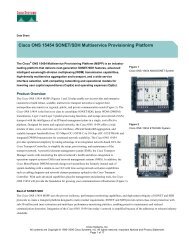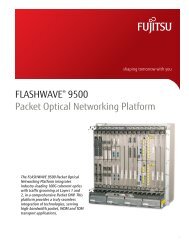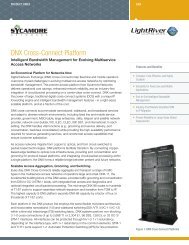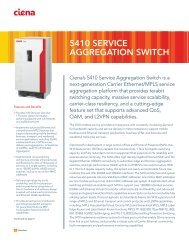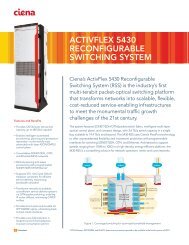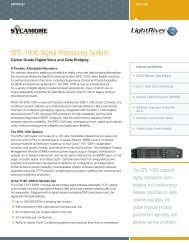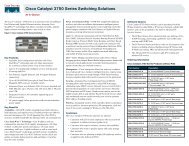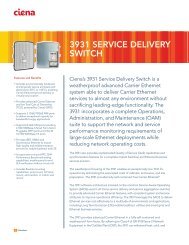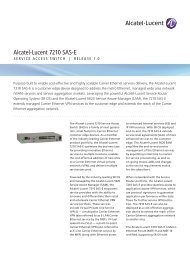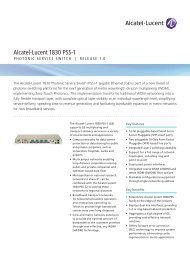Tropos 6320/6310 Mesh Router - Wireless Tech
Tropos 6320/6310 Mesh Router - Wireless Tech
Tropos 6320/6310 Mesh Router - Wireless Tech
You also want an ePaper? Increase the reach of your titles
YUMPU automatically turns print PDFs into web optimized ePapers that Google loves.
<strong>Tropos</strong> <strong>6320</strong>/<strong>6310</strong><strong>Mesh</strong> <strong>Router</strong>The <strong>Tropos</strong> <strong>6320</strong> Outdoor <strong>Mesh</strong> <strong>Router</strong> is designed to provide a cost-effective,easy to deploy, high-performance networking solution for outdoor environments.Lightweight and compact, the <strong>Tropos</strong> <strong>6320</strong> router delivers significant performanceincreases through support for the 802.11n standard, a next-generation high-sensitivity radio design,and the incorporation of new patented features into the industry-leading <strong>Tropos</strong> <strong>Mesh</strong> Operating System.FEATURES AND BENEFITSSoftwarev Decentralized architectureoptimizes throughput in realtimeand ensures scalabilityv Dynamic selection of optimalend-to-end path delivers thehighest performancev Network performance andcapacity maximized by automaticoptimization of powerand rate on per-connectionand per-packet basisPlatformv Support for 802.11n featuresdelivers significant performanceenhancementsv Cost-effective, compact, lightweightdesign streamlines sitesourcing and deploymentv Available in single (2.4 GHz)or dual-radio (2.4/5 GHz)configurationsA cost-effective solution for a wide variety of applications, the <strong>Tropos</strong> <strong>6320</strong> router is well-suited formunicipalities, utilities, enterprise, industrial, and military entities. The <strong>Tropos</strong> <strong>6320</strong> router providesa reliable communications foundation for utility meter reading, intelligent transportation systems,public safety, and video surveillance, and is designed to support multiple applications simultaneously.Each router can either serve as a gateway interface for capacity injection into the network, or as a nodeto extend or reinforce network connectivity.The small, lightweight form factor is ideal for deployments where aesthetics and weight are part ofthe mounting asset equation. Configured with multiple antennas, the <strong>Tropos</strong> <strong>6320</strong> router is fittedwith two Ethernet ports. These ports can be used for a variety of purposes, including capacity injectionfrom a wired or point-to-point wireless broadband link; for attachment of client devices such as avideo camera or Advanced Meter Reading/Advanced Metering Infrastructure (AMR/AMI) collector;or to receive power over Ethernet. The router is available in two versions:v <strong>Tropos</strong> <strong>6320</strong> Outdoor <strong>Mesh</strong> <strong>Router</strong> - Dual-band unit with one 2.4 GHz and one 5 GHz radio.Designed for creating or expanding higher-capacity multi-use networks, the <strong>Tropos</strong> <strong>6320</strong> supportsmeshing and client connectivity on both bands for superior performance, resiliency, and capacity.A scalable solution that protects hardware investments, the <strong>Tropos</strong> <strong>6320</strong> enables the network to beexpanded to support the highest-capacity configurations through deployment of additional <strong>Tropos</strong>routers.v <strong>Tropos</strong> <strong>6310</strong> Outdoor <strong>Mesh</strong> <strong>Router</strong> - Single-band unit with one 2.4 GHz radio. Designed fornetworks with lighter traffic loads, such as collector monitoring for utilities, or for fill-in connectivityin larger systems. A scalable solution that protects hardware investments, <strong>Tropos</strong> <strong>6310</strong>-basednetworks are fully interoperable with dual-band routers - and can be easily expanded to the highestcapacityconfigurations through deployment of additional of <strong>Tropos</strong> routers.802.11n Features Deliver Network-Wide Performance EnhancementsBoth models are designed to utilize the powerful capabilities of the 802.11n standard, which deliversperformance increases in coverage, capacity, and reliability. This breakthrough technology improvesreceive link signal strength and client connectivity not just for 802.11n clients, but for 802.11b/gclients as well. Client connection reliability is enhanced by combining multiple signals from multipleantennas, instead of relying on signals received from a single antenna. The result is increased throughput,higher network capacity, and reduced latency across the network.
<strong>Tropos</strong> <strong>Mesh</strong> OSThe <strong>Tropos</strong> <strong>Mesh</strong> OS is the cornerstone of the decentralized <strong>Tropos</strong>System Architecture. A common software platform that runs on eachrouter across the network, the <strong>Tropos</strong> <strong>Mesh</strong> OS leverages the router’son-board intelligence to monitor and maximize performance. Unlikecontroller-based architectures that suffer bandwidth losses as controltraffic is passed back and forth between network nodes and thecentral site, the distributed <strong>Tropos</strong> System Architecture uses efficienton-board processing at the device level to minimize network congestionand adapt on a real-time, packet-by-packet scale. This distributedapproach optimizes performance and throughput by minimizingcontrol traffic, delivers a highly scalable solution, and helps provide aquality user experience for network clients.PWRPThe cornerstone of the <strong>Tropos</strong> <strong>Mesh</strong> OS is the patented Predictive<strong>Wireless</strong> Routing Protocol (PWRP), which continually analyzesthe quality of active and inactive mesh links to dynamically configurethe ideal combination of paths to optimize network performance.Upon deployment, the routers automatically discover oneanother, and quickly determine the optimal route to the gatewaysthat inject capacity into the network. Optimal links are chosen onthe basis of throughput, packet success, signal-to-noise ratios, andother key criteria.PWRP performs a range of key tasks across the wireless network:v Streamlines deployments and preserves performance by dynamicallyconfiguring and optimizing mesh connectionsv Improves overall throughput by selecting optimal routing pathsv Enhances network resiliency by providing graceful rerouting oftraffic in the event of RF interference, backhaul failures, or otherdisruptions in the wireless meshv Supports client mobility without the need for special client hardware,software, or network reconfigurationsv Enables the network to be scaled to thousands of nodes coveringthe largest geographical areas in the industryPowerCurveA distributed algorithm that leverages the <strong>Tropos</strong> PWRP communicationprotocol, PowerCurve maximizes network performance andcapacity by automatically optimizing power and rate parameterson a per-connection and per-packet basis. This advanced, distributedalgorithm continually adjusts transmit power to maximizethe number of wireless links that can operate concurrently. Unlikealternative approaches where transmit power is configured as a staticsetting, PowerCurve tightly couples power and bit rate control. Thisenables the router to make continuous and dynamic adjustmentsthat can enhance throughput and provide a better user experience.PowerCurve delivers the following key benefits:v Dynamically monitors and adjusts power and rate per-packet,per-link, to deliver maximum capacityv Enhances network reliability, capacity, and scalability beyond thecapabilities of controller-based architecturesv Streamlines network planning, deployment, and optimizationAirtime Congestion ControlAirtime Congestion Control (ACC) technology enables networks to beoperated closer to their capacity limits by detecting signs of congestionand dynamically adjusting airtime resource allocation to clients. ACCis unlike traditional rate limiting in two important ways. First, insteadof limiting traffic during congestion-free periods, ACC activates onlywhen performance-impacting congestion is detected and returns toa monitoring state afterward. Second, it is mesh- and wireless-aware,distributing airtime resources equally among clients during a congestionevent rather than applying fixed throughput caps. By allowing networksto carry heavy traffic loads without crossing over into a saturated state,ACC actually increases usable capacity.v Deterministic allocation of airtime resources enables networks torun at higher capacity without congestionv Monitors airtime availability to deliver more efficient networkutilization than systems relying on limiting traffic levelsv Provides fair network access to all users, enabling <strong>Tropos</strong> tosurpass traditional broadband wireless network capacity
Smart ChannelDesigned to optimize performance in both single- and dual-radionetworks, this distributed algorithm continually samples all availablechannels to analyze link performance and interference trends.The channel decision logic is integrated into the PWRP routingalgorithms so that end-to-end path qualities are assessed on alternatechannels. In dual-radio systems, fine-grained channel plans areimplemented within individual clusters to optimize each cell for clientcoverage and spectral reuse.v Provides continuous monitoring of all channels to detect intermittentnoise sourcesv Non-disruptive to user traffic and sessionsv Avoids interference and enhances network capacity and reliabilityAdvanced Network Management Platform DeliversOptimized Edge-to-Edge Visibility<strong>Tropos</strong> Control is a standards-based network management systemdesigned to achieve peak performance and reliability. Designedaround an intuitive Web-based interface, the software facilitates theremote management of <strong>Tropos</strong> <strong>Mesh</strong> networks, and is ideal fordynamically deploying and configuring networks ranging in sizefrom tens to thousands of <strong>Tropos</strong> routers. <strong>Tropos</strong> Control minimizesplanning, deployment, and operating costs, and increases theefficiency of management personnel by performing complex taskssuch as global provisioning and software updates across the networkin a single session.v Network Health dashboard provides at-a-glance views of networktraffic, performance, and alarms with links to instantly drilldown to relevant statistical informationv <strong>Wireless</strong>-aware provisioning for guaranteed configurationchanges and software updates over dynamically changing linksv Detailed historical database of RF environmental data, networkperformance, and client connectivity enables fast root-causediagnosisv Assists network managers to plan future expansions and optimizationstrategies based on analysis of network trends and detailedhistorical informationResilient, High-Performance Networks From <strong>Tropos</strong> – the<strong>Wireless</strong> IP Broadband Market LeaderAs the leader in wireless IP broadband mesh networking solutions,<strong>Tropos</strong> is the right choice for organizations interested in deployinga robust infrastructure capable of withstanding the harshest outdoorenvironments. Designed to contain costs and enhance productivity,<strong>Tropos</strong> technology provides the backbone for top-performingoutdoor wireless IP networks across the globe. As the industrycontinues to evolve, <strong>Tropos</strong> is poised to extend its market leadershipthrough the introduction of innovative products and functionality.For further information visit us on the web at www.tropos.com.v Streamlines tasks such as monitoringnetwork health, statistical networkperformance analysis, and performanceoptimizationv Provides macro-level visibility as well asgranular real-time and historical detailon usage, link quality, capacity, andnetwork reliability<strong>Tropos</strong> <strong>6320</strong>Mobile Worker802.11 a/b/g/nAlternative wired/wirelessWired Collector
<strong>Wireless</strong>• IEEE 802.11b/g/n radio– Frequency band: 2.4-2.483 GHz– Modulation: 802.11g/n - OFDM (64-QAM,16-QAM, QPSK, BPSK); 802.11b - DSSS(DBPSK, DQPSK, CCK)– Media Access Protocol: CSMA/CA with ACK– TX Power: ETSI/EU 5-20 dBm (EIRP) set in 1 dBunits; FCC/IC 20-35 dBm (EIRP) set in 1 dB units– Multi-Antenna System: 1-TX x 3-RX– Support for 802.11n MRC– 6 dBi Integrated omnidirectional antennas– RX Sensitivity:-97 dBm @ 1 Mbps-96 dBm @ 6 Mbps-84 dBm @ 54 Mbps• IEEE 802.11a radio– Frequency band: 5.725 - 5.850 GHz (FCC/IC)5.470 - 5.725 GHz with DFS (ETSI/EU)– Modulation: 802.11a/n - OFDM (64-QAM,16-QAM, QPSK, BPSK)– Media Access Protocol: CSMA/CA with ACK– TX Power: ETSI/EU 15-30 dBm (EIRP) set in 1dB units; FCC/IC 19-34 dBm (EIRP) set in 1dB units– 8 dBi Omnidirectional antenna– RX Sensitivity:-94 dBm @ 6 Mbps-76 dBm @ 54 MbpsNetworking• Full 802.11b/g, 802.11a, 802.11n clientcompatibility• IEEE 802.3u autosensing 10/100BASE-TEthernet ports• IPv4; IPv6-ready• BGP• 802.1q VLAN support (ESSID and IP basedtagging)• Support for static and dynamic addressing forwireless and wired clients• Onboard DHCP Server and Relay• Session-persistent mobility across subnets• Network Address Translation (NAT)• IP multicast forwarding, IGMPv3; IGMP Proxy• Automatic rate, power, channel and band control• PowerCurve• Smart ChannelQuality of Service• 802.11e WMM• 802.1p/q with 4 queues per VLAN and ESSID• 802.1p and DSCP• VoIP and VoWiFi Support– Heuristics-based Voice Classification– Call Admission Control– TSpec Classification– Seamless Mobility– Call Reporting• Rate Limiting (Airtime and Throughput Based)• ACC - airtime congestion controlManagement• RADIUS Accounting• Local and Remote Management Tools viaHTTPS• Identity-Based Authentication (4 levels)• Configuration Save and Restore• Software Upgrades with Rollback• Command Line Interface (CLI) via SSH• SNMP (standard MIBs)• <strong>Wireless</strong>, Network and Client Monitoring andStatistics• Infra Red (IR) port• <strong>Wireless</strong> rescue• Dual image• Auto recoverySecurity• IPsec VPNs with tunnels to wired client interfacesusing AES• Authentication: WPA, WPA2, 802.11i, RADIUS,802.1x (includes EAP-TLS, EAP-TTLS, EAP-SIM,PEAP)• Encryption: open, WEP, TKIP, AES-CCM• AES encryption of mesh and control traffic• FIPS 140-2 Level 2 compliant• NERC CIP 002-009 compliant• Multiple BSSIDs & ESSIDs (ESSID suppression)• Integrated firewall– Packet filtering based on TCP port , protocol,SA, DA– Peer-to-peer blocking– Client access control lists– <strong>Router</strong> access control• Evil twin detection and reporting• Denial of service (DoS) attack detection andreportingEnvironmental Specifications• Operating temperature range: -40°C to 55°C• Storage temperature range: -40°C to 85°C• Weather rating: IP67 UL579/IEC 60529 IP67• Wind survivability: >165 mph• Wind loading (165 mph):


